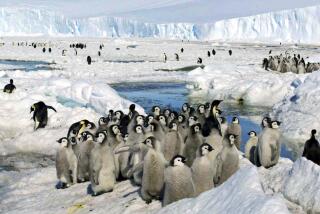Penguinsâ march from wings to fins saved energy
The march of the penguins seems to mock evolution. If Emperor penguins just got up and flew 40 miles, they could get to their mates in no time flat. Why would evolution abide a tedious waddle across the ice?
It turns out thereâs method in the seeming madness of these blubbery short-winged pedestrian birds. Penguins long ago faced a steep trade-off between the high calorie costs of flight and low energy expenditure of using their wings to swim. They dived into an âadaptive fitness valleyâ of evolution that fly-and-dive ocean birds such as murres and cormorants still straddle, according to a team of Canadian and American zoologists.
This biomechanical theory for winged flightlessness emerges from a study that measured energy efficiency in thick-billed murres â seabirds also known as guillemots, in the Auk family â and in cormorants.
Murres resemble penguins in their diving and swimming â âflight-basedâ propulsion by strong wings. But murres can still fly.
That lingering multi-tasking costs murres and other diving sea birds in ways that penguins donât pay. The metabolic cost of flight for murres is the highest ever recorded for vertebrates, according to the study published Monday in the Proceedings of the National Academy of Science. Murres operate at 31 times their base metabolic rate while flying, placing them at the outer edge of energy efficiency among vertebrates.
Dive costs for murres were lower than those for cormorants, another fly-dive species that uses a âdrag-basedâ paddle, like ducks. But the penguin still beats both in diving energy efficiency.
âLike many people, I have been fascinated by films of penguins walking across the Antarctic ice, and wondered, why on earth they lost the ability to fly?â said University of Aberdeen zoologist John Speakman, a member of the research team. âThe lack of flight in penguins has been an enigma, because it leads to some seemingly poorly adapted behavior.â
But penguins are well adapted for finding food in water â adaptions that progressively made flying impossible: Their wings became shorter, with stouter bones. Their body mass increased, both to optimize muscle contraction rates for the slower wing beats, and to allow them to store more energy for longer dives.
These compromises are lacking in the murres, a chubby-bodied flier that has the highest wing loading of any flying bird, according to the study. It needs a whopping 146 watts per kilogram of weight to take flight, more than the record held by a bar-headed goose. A cormorant needed 87 watts per kilogram.
And dive costs increase rapidly with body mass for flying divers such as the murre, compared with flightless divers, such as the penguin. That places the murre at the edge of the âfitness valleyâ separating winged fliers and their flightless swimming avian cousins, the researchers suggest.
The penguins, however, pay a price for their efficiency: they became the favored prey of leopard seals while in the ocean.
That should be motivation enough for penguins to become even better swimmers.







